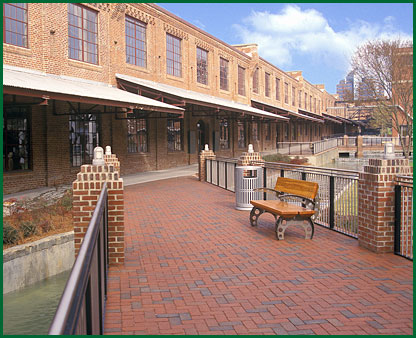American Tobacco Historic District Renovation
Words: Dan Kamys
CASE STUDY #3
Transforming an industrial complex into a vibrant, mixed-use "district"

Durham, N.C.
The project called for creating a new life for a dormant industrial complex composed of 10 buildings constructed between 1874 and 1954 in downtown Durham, N.C. The existing brick buildings, enclosing more than 1 million square feet in various states of disrepair, surround a central courtyard containing the site's signature water tower. Belk Architecture's task was to adapt the former factory into a vibrant, mixed-activity center, while retaining and enhancing the architectural integrity of the buildings. Existing buildings were carefully repaired and restored, new interior lobbies were created, and two new parking facilities were integrated into the campus. Inside the courtyard, the water tower and brick chimney were stabilized and repainted, asphalt removed and replaced with landscaping and lawn, and a new water feature created. The water feature is a 440,000-gallon re-circulating river flowing through the project, Bull River.
The landscape architecture firm of Smallwood, Reynolds, Stewart, Stewart & Associates used brick pavers to tie the surrounding buildings together. The architect developed a blend of colors, since the buildings each varied in color. Clay brick was the only material considered, as they didn't want to introduce new materials into this historic district. Bold diagonal lines are used for direction, and the bridges crossing the river are covered with brick pavers to connect the site.
Two paving systems were used on the project: brick set on an aggregate base and brick set on a concrete slab. In both cases, a sand-setting bed was used. The sand used for the setting bed conformed to ASTM C 33 concrete sand, since it provides better drainage than a mason's sand. The bridge had originally been designed as a steel bridge, but availability of steel was a problem. It was redesigned as a concrete bridge with a clay paver surface. The concrete deck served as a base for the clay pavers, which were then set in a sand-setting bed. Other areas of the project used an aggregate base, in many cases only four inches thick, to satisfy the pedestrian-only traffic. The contractor followed the Brick Industry Association's installation guidelines (Technical Notes 14 Series) to ensure a good job was performed.
Phase 1 of the redevelopment created an office, retail, restaurant and leisure destination with activity at the site continuing day and night. The use of brick has tied this unique development together. Surrounded by history and tradition, the "District" has become one of Durham's most active urban spaces.
Case Studies: Pavers in Hardscaping
— Medinah Country Club
— Northeastern University
Side Story: